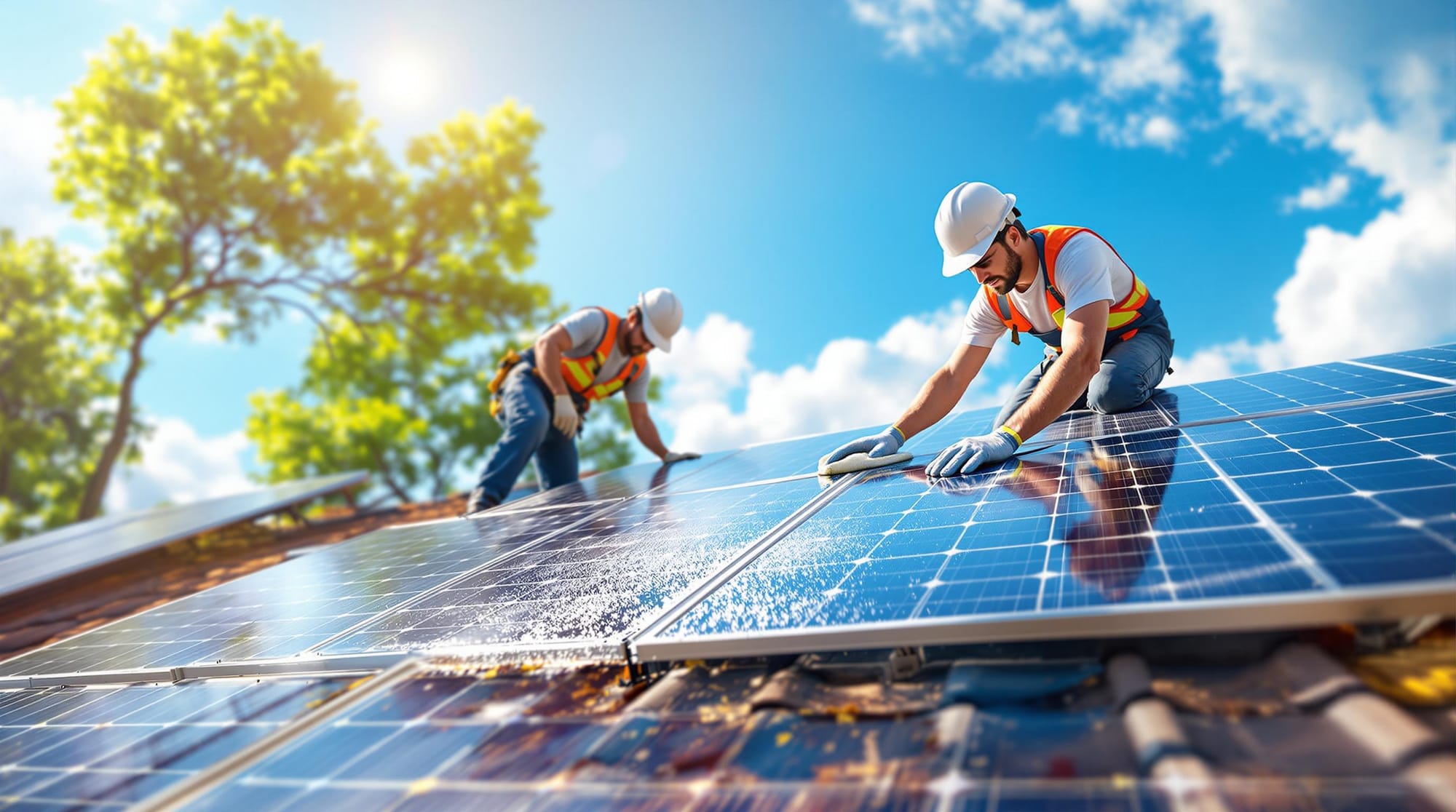Common Solar Efficiency Problems and Fixes
Learn about common solar panel efficiency problems and effective solutions, including shading, dirt buildup, heat, and electrical issues.

Solar panels can lose efficiency due to common problems like shading, dirt buildup, overheating, and electrical issues. The good news? Simple fixes like trimming trees, regular cleaning, improving airflow, and professional maintenance can restore performance and save you money.
Key Solutions at a Glance:
- Shading: Trim trees, reposition panels, or use power optimizers.
- Dirt/Debris: Clean panels every 3–6 months to avoid up to 25% efficiency loss.
- Heat: Ensure proper ventilation and use heat-resistant setups.
- Electrical Issues: Schedule professional inspections and upgrade outdated components.
With regular maintenance and smart practices, your solar system can perform 15–20% better and last its full 25–30 year lifespan. Let’s dive into the details.
Top 5 Solar System Maintenance Problems and Solutions
Shade Problems and Solar Panels
Even a small amount of shade on one solar panel can significantly cut down the overall energy output of your system. That’s why it’s important to identify the sources of shading and address them properly to keep your panels working efficiently.
What Causes Shade Problems?
Shading can come from various sources, and these can change throughout the day or year. Here are some common culprits:
- Trees and Plants: Growing trees or overgrown vegetation can cast shadows, and the problem gets worse as they grow taller.
- Roof Features and Nearby Structures: Chimneys, vents, satellite dishes, or even neighboring buildings can create shadows on your panels.
- Seasonal Sun Changes: During winter, the sun is lower in the sky, which can create longer shadows that weren’t an issue in summer.
- Debris and Weather: Snow, fallen leaves, or other debris can temporarily block sunlight and reduce energy production.
How to Address Shade Issues
Taking steps to minimize shading is key to getting the best performance from your solar panels. Here’s how:
Smart Panel Placement
- Place panels in areas that get consistent sunlight between 9 AM and 3 PM.
- Install panels at a height that avoids shadows from nearby objects.
- If roof placement isn’t ideal, ground-mounted systems can be a good alternative.
Manage Vegetation
- Regularly trim or remove trees and branches that block sunlight.
Use Technology to Minimize Impact
- Equip your system with tools like micro-inverters, power optimizers, bypass diodes, or adjustable mounts to reduce the effects of shading.
Before installing your system, a professional shade analysis can help map out potential shadow patterns throughout the year. This ensures your panels are positioned for maximum energy production. Up next: learn how regular cleaning and maintenance can further improve performance.
Cleaning and Maintenance
Keeping your solar panels clean is essential for maintaining their energy output.
How Dirt Impacts Energy Production
When dirt and debris cover your solar panels, they block sunlight, reducing their ability to generate electricity. According to the National Renewable Energy Laboratory (NREL), the effects can be significant:
- Light dirt buildup can lower efficiency by 3-7%.
- Heavy accumulation from neglect may slash output by up to 25%.
- Bird droppings and tree sap are especially harmful, creating localized hot spots that can damage the panels.
Certain factors make frequent cleaning even more important, such as:
- Living near construction sites or dusty roads.
- High pollen levels in your area.
- Long dry spells without rain.
- Proximity to industrial zones.
Using the right cleaning methods can help restore lost efficiency.
Best Cleaning Practices
When and How Often to Clean
- Clean your panels early in the morning or late in the evening to avoid working on hot surfaces.
- Plan cleanings every 3-6 months, depending on your environment.
- Consider additional cleanings after storms or during heavy pollen seasons.
Safe Cleaning Techniques
- Use soft brushes and non-abrasive tools to avoid scratching the panels.
- Rinse with deionized water to prevent mineral buildup.
- Skip harsh chemicals or pressure washers, as they can damage the surface.
- For snow, use rubber-tipped tools designed for solar panels.
Proper cleaning ensures your system operates at its best.
| Cleaning Method | Best For | Avoid |
|---|---|---|
| Soft brush with extension pole | Routine cleaning | Metal brushes |
| Deionized water | General maintenance | Tap water (leaves residue) |
| Specialized solar panel soap | Heavy dirt buildup | Household detergents |
| Rubber snow rake | Snow removal | Metal shovels |
DIY or Professional Cleaning?
Professional cleaning services might be the way to go if:
- Your roof is steep or panels are hard to reach.
- You notice a sharp drop in energy output.
- Your insurance policy requires professional maintenance.
If you prefer DIY, stick to regular monitoring and gentle cleaning techniques. Always use safety gear and follow the manufacturer’s recommendations for cleaning tools and products.
Heat and Performance Loss
Excessive heat is another factor that can lower the efficiency of solar panels, alongside shading and dirt. High temperatures can reduce their performance, especially during peak sunlight hours.
How Heat Affects Solar Panels
Solar panels start losing efficiency when temperatures climb above 77°F (25°C). For every 1°C increase beyond this threshold, energy output drops by about 0.3–0.5%. During hot summer days, rooftop panels can heat up significantly, leading to power losses, faster wear on components, and a shorter lifespan for inverters.
Let’s look at some practical ways to minimize these heat-related issues.
Ways to Reduce Heat Impact
Here are a few strategies to help manage high temperatures:
Smart Installation Design
- Mount panels slightly above the roof using light-colored hardware or reflective coatings. This improves airflow and reduces heat absorption.
Cooling Solutions
- Increase airflow or ventilation around the panels, or consider water cooling systems to keep temperatures in check.
Choosing the Right Panels
- Opt for panels designed to handle heat better. Look for those with low temperature coefficients, anti-reflective coatings, and inverters equipped with advanced cooling features.
Regular Monitoring and Maintenance
- Keep an eye on panel temperatures, schedule maintenance during cooler parts of the day, and ensure ventilation areas remain clear to avoid hot spots.
Some setups even use bifacial panels, which allow for better rear ventilation. These panels tend to perform better in hot conditions compared to standard models, making them a good choice for heat management.
Electrical System Problems
Electrical issues can significantly impact the performance of your solar system. Keeping the system in good shape requires attention to wiring, components, and overall electrical integrity.
Common Wiring and Component Issues
Here are some frequent electrical problems that can affect solar systems:
- Inverter Malfunctions: Aging components, outdated DC-to-AC conversion technology, or overheating during summer months can reduce efficiency.
- Connection Problems: Corroded terminals, loose MC4 connectors, or weather-damaged junction boxes can disrupt power transfer.
- String Configuration Issues: Mismatched panel voltages, improper wiring, or ground faults can lower system output or even cause shutdowns.
Fixing Electrical Problems
To address these issues and maintain peak performance, consider these approaches:
- Professional Maintenance: Schedule regular inspections with certified technicians. They can use tools like thermal imaging, voltage and current measurements, and resistance tests to identify hot spots, loose connections, and ground faults.
- System Upgrades:
- Replace old string inverters with microinverters for better efficiency.
- Add smart monitoring systems to detect problems early.
- Upgrade wiring with weather-resistant components to handle harsh conditions.
- DIY Monitoring: Homeowners can play a role by:
- Tracking daily power output for irregularities.
- Checking inverter displays for error messages.
- Listening for unusual sounds from the system.
- Using mobile apps to monitor alerts and performance.
Routine checks and maintenance are essential for keeping your solar system running efficiently. However, electrical problems can be hazardous. Always consult a certified solar technician for repairs involving high-voltage components or complex wiring.
Summary
Here's a quick overview of common issues that can lower solar panel efficiency and how to address them.
Keeping solar panels running efficiently means tackling problems like shading, dirt buildup, heat, and electrical issues. Regular maintenance can make a big difference - well-kept systems can perform 15%–20% better than those left unchecked.
| Issue | Impact | Solution |
|---|---|---|
| Shade | Up to 25% power loss | Trim trees, reposition panels, or add power optimizers |
| Dirt/Debris | 5–15% efficiency drop | Clean panels quarterly, either professionally or with careful DIY methods |
| Heat | 0.5% efficiency loss per degree above 77°F (25°C) | Ensure proper ventilation and use heat-resistant mounting systems |
| Electrical | Variable performance drops | Schedule professional inspections and upgrade components as needed |
Maintenance Schedule
- Monthly: Perform visual checks and monitor performance.
- Quarterly: Clean panels and clear debris.
- Annually: Conduct a full system inspection, including electrical components.
- Every 5–7 years: Inspect and possibly replace the inverter.
Modern monitoring systems can detect even small efficiency drops (as little as 2%), allowing you to act quickly. While homeowners can handle basic tasks, electrical issues should always be left to certified professionals to ensure the system remains in top shape for its 25–30 year lifespan.

